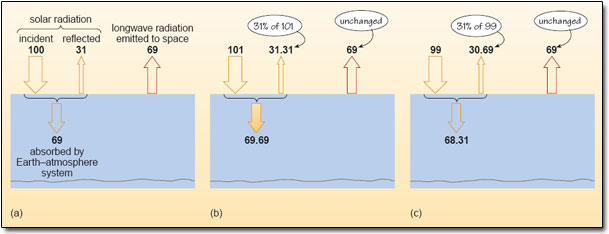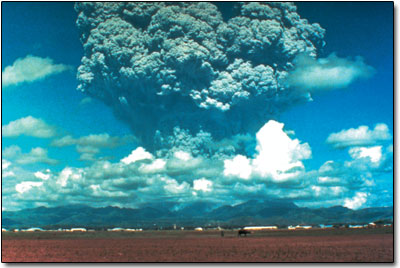1 Global climate and the greenhouse effect
1.5 ‘Radiative forcing’ as an agent of climate change
Since its first major report in 1990, the IPCC has used the concept of ‘radiative forcing’ as a simple measure of the importance of a potential climate change mechanism. The basic idea is straightforward. Any factor that disturbs the radiation balance at the top of the atmosphere has the potential to ‘force’ the global climate to change: it will either warm up or cool down until a balance is restored. The perturbation to the energy balance of the whole Earth-atmosphere system is called radiative forcing, and is given in the units W m−2.
Look back at Figure 12. What three factors could disturb the radiation balance at the top of the atmosphere?
A change in the Sun's output, and hence in the solar constant; a change in the Earth's albedo; and a change in the longwave emission to space.
Among the more enduring hypotheses to account for climate change are those based on the idea that the Sun is a variable star and that its output of energy varies through time. Indeed, this idea underlies the sceptical view that recent global warming has little to do with human activities; rather, the argument goes, solar variability is the main culprit. We shall come back to that issue in Section 2. For now, we use the possibility of solar variability to put some flesh on the notion of radiative forcing.
To that end, Figure 13 illustrates the effect of a 1% change (up or down) in the solar constant, and hence in the globally averaged solar radiation intercepted by the Earth (the 100 units in Figure 13a). Assuming that the planetary albedo is unchanged (at 31%), an increase in the solar constant (Figure 13b) produces a positive radiative forcing: the rate at which the Earth-atmosphere system absorbs solar radiation (69.69 units) is now greater than the rate at which it emits longwave radiation to space (69 units). This has a warming effect. Conversely, a reduction in the solar constant (Figure 13c) produces a negative radiative forcing, which has a cooling effect.

Figure 13: (a) The globally averaged radiation balance at the top of the atmosphere from Figure 12 (i.e. 100 units is equivalent to 342 W m−2). (b) and (c) The imbalance induced by a 1% increase or decrease, respectively, in the solar constant, assuming no change in the planetary albedo.
Question 4
According to Figure 13, what is the radiative forcing, in W m−2, associated with a ±1% change in the solar constant?
Answer
The radiative forcing is the difference between the rate at which the Earth–atmosphere system absorbs solar radiation and the rate at which it emits longwave radiation to space. From parts (b) and (c) of Figure 13, the magnitude of the radiative forcing is (69.69 − 69) units or (69 − 68.31) units = 0.69 units, which is equivalent to (342 W m−2/100) × 0.69 = 2.4 W m−2 (to 2 significant figures). The forcing is positive for a 1% increase in the solar constant (Figure 13b) and negative for a 1% decrease (Figure 13c).
Explosive volcanic eruptions spew vast quantities of gases and fine-grained debris (volcanic ash) into the atmosphere. The greatest eruptions are sufficiently powerful to inject material high into the stratosphere, where it gradually spreads around the world. The result can be a significant and widespread cooling effect on climate (see Box 5).
Box 5 1816: the ‘year without a summer’
The bright sun was extinguish'd, and the stars
Did wander darkling in the eternal space,
Rayless, and pathless, and the icy earth
Swung blind and blackening in the moonless air;
Morn came and went – and came, and brought no day,
And men forgot their passions in the dread
Of this their desolation.
(Lord Byron, Darkness, 1816)
The largest volcanic event of modern times was the eruption of Mount Tambora in Indonesia in April 1815. Where records exist, they reveal a period of abnormally cold weather that prevailed during the spring and summer of 1816 in many parts of the Northern Hemisphere. The effects were especially severe in the northeastern United States, with average temperatures in New England up to 3.5 °C below normal in June, for instance, and unseasonal frosts and snowfalls. Europe was also badly affected, leading to crop failures and famine in England, France and Germany. The below-average temperatures lasted for about two years.
In the summer of 1816, there were also widespread reports of a dim Sun, or persistent haze that was not dispersed by surface wind or rain (since it was actually up in the stratosphere) – though few captured its effects as powerfully as Byron's poem.
Why might a major volcanic eruption be expected to have a cooling effect on climate at the Earth's surface?
It increases the load of aerosols in the stratosphere, potentially increasing the absorption of incoming solar radiation in this region and/or scattering more of it back to space (Section 1.3). Both effects cause a cooling at the surface
Although one of the more dramatic features of a major eruption (Figure 14), volcanic ash has little enduring impact on climate because it settles out of the stratosphere within a few months. Far more important is the amount of sulfur dioxide (SO2), one of the volcanic gases, emitted during the eruption. Chemical reactions rapidly convert the gas to droplets of sulfuric acid, and these sulfate aerosols can remain in the stratosphere for several years (the persistent haze of Box 5). Their main effect is to increase the back-scattering of solar radiation.

Figure 14: The explosive eruption of Mount Pinatubo in the Philippines in June 1991 devastated the surrounding area and sent about 25 × 109 kg of SO2 into the stratosphere. Over the following year, the haze of sulfate aerosols travelled around the world and lowered the average surface temperature in the Northern Hemisphere by about 0.5 °C.
With this in mind, how would you describe the climatic effects of a major volcanic eruption in terms of radiative forcing?
The extra load of stratospheric aerosols effectively increases the planetary albedo (the second of the three factors identified at the beginning of this section), and this constitutes a negative radiative forcing. (The effect is analogous to a reduction in the solar input.)
The resulting cooling effect can be significant (as noted in connection with the Pinatubo eruption in Figure 14), but only on a relatively short-term basis – typically, 1–3 years at most. Air movements gradually carry the sulfate aerosols down into the troposphere, where they are usually washed out by rain within a few weeks.
But how does an increase in the atmospheric burden of greenhouse gases lead to a radiative forcing of climate? Again we use an illustrative example. Suppose the atmospheric concentration of CO2 is doubled instantaneously (known as a CO2-doubling), but everything else (the solar input, planetary albedo, concentrations of other greenhouse gases, etc.) remains the same. What would be the immediate effect? With more molecules of CO2 in the atmosphere, a higher proportion of the outgoing longwave radiation would be absorbed, reducing the net emission to space. Complicated, but well-understood, calculations give a reduction by about 4 W m−2 (from 236 W m−2 to 232 W m−2) for a CO2-doubling.
Does this change represent a positive or negative radiative forcing?
The forcing is positive. The effect is analogous to an increase in the solar constant (by rather more than 1%, according to Question 4).
There is no dispute about this central conclusion. Increasing the atmospheric concentration of CO2, or any other greenhouse gas, will force the global climate to warm up; we shall often refer to this as ‘greenhouse forcing’. However, the weighty tomes issued by the IPCC bear witness to the fact that ‘the devil is in the detail’! In particular, there is still major uncertainty about what is perhaps the most fundamental question in the whole climate change debate: how much will the Earth's GMST rise in response to a given amount of greenhouse forcing? We shall revisit this question many times as the topic unfolds. Here, we focus next on what is known about the amount of greenhouse forcing to date.
